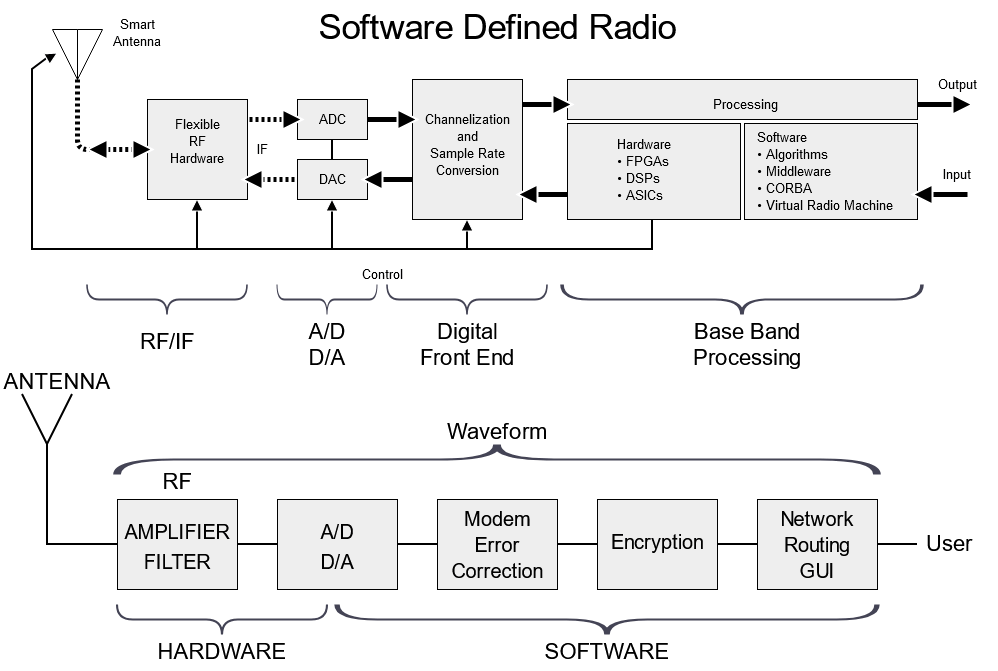Software-Defined Radio (SDR) is a technology that allows for the implementation of radio communication systems using software-based techniques. In traditional radio systems, hardware components are designed to perform specific functions, such as modulation, demodulation, and filtering. In contrast, SDR replaces many of these hardware components with software, allowing for greater flexibility and reconfigurability.

Here are some key points about Software-Defined Radio (SDR):
- Definition: SDR is a technology that replaces traditional hardware components in radio systems with software-based functionality.
- Flexibility: SDR allows for the reconfiguration and adaptability of radio systems through software updates, enabling support for various communication protocols and standards.
- Hardware and Software Components: SDR systems consist of a radio front-end with analog-to-digital converters (ADCs) and digital-to-analog converters (DACs), along with a software platform that controls signal processing, modulation, and demodulation.
- Functionality: SDR systems implement functions such as filtering, modulation, demodulation, channel coding, and decoding using software algorithms running on general-purpose processors or specialized digital signal processors (DSPs).
- Adaptation to Change: SDR technology enables radio systems to quickly adapt to evolving communication requirements without the need for hardware modifications, ensuring compatibility with new standards and protocols.
- Applications: SDR finds applications in wireless communication systems, military and defense, public safety, satellite communication, and amateur radio, among others.
- Benefits: SDR offers advantages such as improved spectrum efficiency, reduced hardware complexity, simplified system integration, and enhanced flexibility in radio communication.
- Upgradability: SDR systems can be upgraded and enhanced through software updates, allowing for future improvements and capabilities.
- Software-Defined Networking (SDN): SDR can be integrated with SDN principles to enable dynamic management and control of radio resources within a network.
- Research and Development: SDR technology continues to evolve, with ongoing research and development efforts aimed at improving performance, and efficiency, and expanding its capabilities.
Related reference: USRP Universal Software Radio Peripheral
SDR systems typically consist of a hardware platform, known as the radio front-end, and a software platform that controls the signal processing and modulation/demodulation functions. The radio front end usually includes analog-to-digital converters (ADCs) and digital-to-analog converters (DACs) for converting analog signals to digital and vice versa.
The software platform of an SDR system handles various functions, including filtering, modulation, demodulation, channel coding, and decoding. These functions are implemented using software algorithms running on a general-purpose processor or a specialized digital signal processor (DSP). The flexibility of SDR allows for the implementation of different communication protocols and standards through software updates, without requiring hardware modifications.
One of the key advantages of SDR is its ability to adapt to changing communication requirements. It enables the support of multiple frequency bands, modulation schemes, and protocols, making it suitable for a wide range of applications. SDR systems can be reconfigured and upgraded through software, allowing for future enhancements and compatibility with new standards.
SDR technology finds applications in various domains, including wireless communication systems, military and defense, public safety, satellite communication, and amateur radio. It offers benefits such as improved spectrum efficiency, reduced hardware complexity, simplified system integration, and enhanced flexibility in radio communication.
Overall, Software-Defined Radio enables the realization of radio communication systems with greater adaptability, configure-ability, and scalability, contributing to the advancement and evolution of wireless communication technologies.
References:
- https://en.wikipedia.org/wiki/Software-defined_radio
- https://www.everythingrf.com/community/what-is-a-software-defined-radio
Related Articles
- Electronics and Communication Engineering Seminar Topics
- 499 Topics for Seminars on Electrical and Electronics Engineering
- Universal Software Radio Peripheral
Collegelib.com prepared and published this curated seminar topic ideas for Electronics and Communication Engineering seminar topic preparation. Before shortlisting your topic, you should do your research in addition to this information. Please include Reference: Collegelib.com and link back to Collegelib in your work.